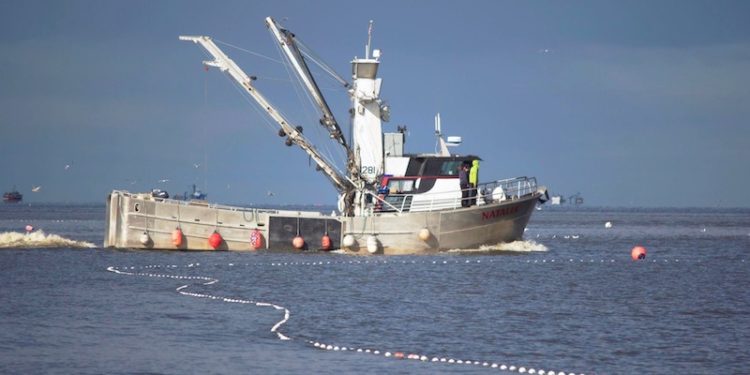When Ray Wadsworth’s Kodiak Marine Construction of Squim, Washington built the Order of Magnitude in 1990, fuel was cheap and roe herring prices were high. Back then he was looking for an edge on the competition and bought it by installing a 3000hp gas turbine in his new 17.6 by 4.40 metre (58 x 14.5 foot) aluminium seiner. Minutes can make a difference in getting in position to set on the herring.
Ray Wadsworth also designed his own 32-inch water jet for the boat and included an auxiliary Cummins KT19 at 425hp for moving at a slower speed as a displacement hull for fishing with a more economical fuel burn. In that original configuration, both engines turned the water-jet through a single transmission.
However, when fuel and fish prices dictated a rethink on the boat, out came the gas turbine and the jet. The Cummins KT19 stayed, with the addition of a Twin Disc 514 gear with 2:1 ratio and a 32 by 36-inch four-blade prop in a tunnel.
The boat had done 52 knots with the gas turbine and fast is nice – but burning a thousand litres per hour doesn’t leave much to take home. The boat seined profitably on the KT19 diesel with an eight-knot speed.
By the time Bruce Schactler bought the boat in 2006, the fishery and the fuel price had settled into the new reality. The Japanese market for roe herring had tanked. The price of fuel had more than doubled. The herring were fetching about a quarter of what they had peaked at in the 1990s.
Bruce saw the potential in the aluminium boat. At the same time he realised that it had been built for speed with only an 18-tonne RSW and a 22.5 tonne cargo capacity. In 2007 he had Craftsmen United in Port Townsend sponson the hull to add another 2.40 metres to the beam bringing it up to 6.86 metres with the same 2.10 metre moulded depth.
This increased the cargo capacity to 36 tonnes in two holds, both chilled with a new 30-tonne RSW system. A 70kW genset provides for the refrigeration while a 10kW set provides domestic power.
On deck, the well set up fishing gear includes a 24-inch Kolstrand line hauler for pursing along with Kinematic and Pullmaster winches. A beefy six-inch main boom is supplemented by two four-inch diameter picking-booms.
Bruce Schactler renamed the boat Natalia as a part of its on going transformation. The addition of the sponsons represented a dramatic step in this evolution, as did the earlier removal of the gas turbine and jet. Perhaps the most consistent piece of the boat has been the six-cylinder Cummins KT19 main engine. While it transitioned from turning a jet drive to a prop, it has remained a reliable component of a great boat.
At the end of the 2017 fishing season the engine had clocked a remarkable 53,000 hours. Bruce Schactler decided it was time to replace the venerable diesel. He got McKay Marine of Newport Oregon to supply another new Cummins KT19, which made for an easier install in Kodiak by him and his crew.
Three pressure-compensated Spencer hydraulic pumps run off of a Funk drive gear on the front of the main engine. The engine is set aft in Natalia so it turns the same four-blade prop through the same 2:1 reduction via a ten-foot long 2.5-inch shaft. The new engine, like the old, is rated at a relatively low 425hp to provide the best match to the hull for a comfortable eight-knot cruising speed.
His current annual round includes fishing herring in Togiak in April or May, tendering salmon in Bristol Bay in June and July, when the shallow five-foot maximum draft and large RSW system show their value. Finally he seines salmon in Kodiak in August and September. Times change and the best boat for the job can change. Natalia has been able to add some beam and reduce some horsepower, but with a new main engine she will, in the years to come, chase a lot more herring and salmon for her owner.









